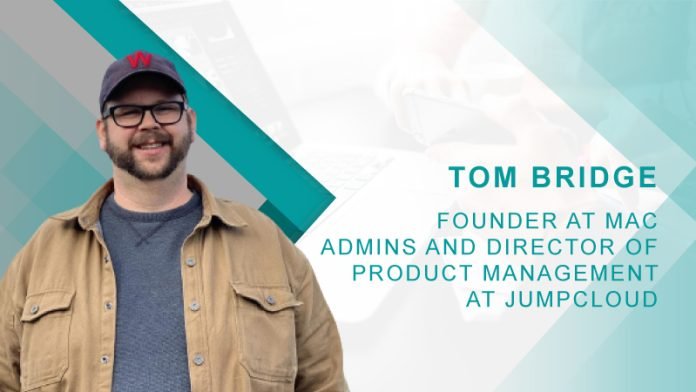Tom, kindly brief us about yourself and your professional journey.
My name is Tom Bridge, I’m the Director of Product Management for Device Management at JumpCloud. I started my career in Information Technology at 22, fresh out of university. I spent five years learning the craft at an education non-profit based in Washington, DC. I learned how to build a new office, how to get devices ready for new deployments, and how to manage accounts and services. After that, I spent 15 years building a consulting firm to handle these issues for small- and medium-sized businesses all throughout the Eastern Seaboard. I spent a lot of those 15 years learning how small businesses hire people, let them go, provide them equipment, and manage their work life. JumpCloud reached out in January of 2021 with an opportunity to level myself up by joining their product team as a product manager for our Apple technologies, and that started an exciting journey into the world of building products.
What led you to your interest in the space between IT and HR?
Small businesses are the lifeblood of the economy, and they have so many unique challenges. At most of the organizations I worked with as a consultant, the primary interface for us at the organization was the HR department. Organizations had substantial tech needs during onboarding and offboarding, and it was a huge pain point for HR departments not to have great tools to build automated workflows with, and it seemed like a good set of tools connecting HR practitioners to their IT systems was a great way to help everyone have a better time. IT teams want to help people, much like HR teams do, but each has their own guidelines and strictures that need to be understood.
What are the key benefits of integrating HR and IT stacks within organizations, and how can this integration positively impact overall business efficiency and employee experience?
Automation, automation, automation! The less you have to do when you have a new hire, the easier it is to hire more people, or to focus on more critical development tasks for HR professionals. The more that HR can bring to the IT department as fully completed, the less IT has to do to get a new person equipped to do their job.
For IT admins, what are the most significant challenges they may encounter during the integration process, and how can they effectively address these challenges?
IT admins need to be more familiar with HR workflows and systems, but as soon as you can connect the two and have data flowing back and forth, the sooner you’re going to have to do less, and rely on actions more. It’s so crucial that admins understand why they’re doing these key tasks, that makes their priority clearly visible to all parties.
Are there any best practices that IT admins should follow when integrating HR and IT stacks?
Like most key systems, admins need to understand the rules of “least privilege” and “least access” are applicable. HR data is some of the most private data in the company, and that they may not even be able to access it themselves. They should coordinate with the HR team to have appropriate access necessary for enabling these workflows, and no more. Where possible, bearer credentials should be used and documented. It’s also very important to, when connecting these systems for the first time, to test all the workflows that are available.
In the initial stages, what are the recommended first steps that organizations should take to lay a solid foundation for integrating their HR and IT systems seamlessly?
It’s important to have a set of working guidelines and principles to protect each side of this equation. Sometimes that’s as simple as “which systems can delete data? Which systems can’t delete data?” and sometimes it’s a complicated agreement of checks and balances. Start small. Agree on who’s going to be involved. Agree where you are on the RACI matrix for each system.
It’s also really, really important to have a common set of outcomes that you’re working toward. They can be notional or aspirational, as well as practical, but they need to be written down so you can measure progress toward the goals.
As organizations grow and expand, what are the best ways to scale the integrated HR and IT stacks effectively?
Every process needs a run book, so that any person from either team can easily understand the process that’s about to be completed. Onboarding a new hire? Figure out what they need to be successful and who will provide access, hardware, and training for the new person, and then codify that process. Scaling your organization is about making sure that knowledge is transferred easily and quickly within the team, and that means providing common, shared knowledge bases for each party to review, keeping them up to date, and providing training on how to use them.
Considering the varied nature of HR and IT systems across organizations, how can IT teams ensure compatibility and data consistency during the integration process, without disrupting existing workflows?
This comes down to testing, pure and simple, and sometimes it can help to have a “sandbox” environment for both your HR and IT systems so that admins can make changes on systems that look like – but, importantly, are not – your production data stores. HR and IT data are both incredibly important to keep working, so practicing on a sandbox before connecting a new service is really a crucial step to conducting a proper integration.
It’s also incredibly important to keep your messaging up with your teams while you’re adjusting systems, to make sure that any flaws in a data flow are caught early, and in such a way that damage can be mitigated if not reverted. Getting a broad team available from within the organization to help safeguard your pipelines is very important!
Collaboration between HR and IT teams is essential for successful integration. Can you share any insights or experiences on fostering effective communication and cooperation between these departments during the integration process?
Regular communication opportunities between these two critical departments is absolutely essential to keeping everything moving. Understanding the cadences of new hires – and their attendant hardware and software needs – will influence a lot of the different teams within the administration of a business. Clear communication, driven by a desire for mutual understanding and respect, is the foundation that any organization needs to have between its business units. If either side isn’t able to keep up with the cadence, resourcing has to be a topic of conversation, and establishing a clear set of priorities for projects needs to be agreed to and communicated throughout the organization.
These departments are all about creating partnerships and fostering teamwork throughout the whole organization. If you’re leading through partnership internally, you’re going to have a better, more scalable experience for your team at the office.
In your opinion, how does the integration of HR and IT stacks impact overall organizational culture and employee engagement? Are there any specific factors that contribute to a positive cultural shift resulting from this integration?
Continuity between HR and IT means your new hires have exactly what they need on Day One, and they’ve got an incredible onboarding experience that leaves them excited to get started on their first day. First days are like magic, when they work right, they validate a new hire’s excitement and remind them of the great decision they made to switch organizations and join your team. If it’s wrong, though, some new hires can doubt their decision, and that can lead to an early departure. The culture shift that aligns HR and IT into common cause means everyone’s working toward the same goal: a great IT experience that empowers team members to reach their full potential at work.
Throughout your experience, have you encountered any unique or challenging scenarios during HR and IT stack integration? How did you address these situations, and what lessons can other IT admins learn from your experiences?
There are always challenges in aligning systems. Most importantly, though, you have to be ready to walk away from a bad solution to a problem and find a better one. I remember at one organization, they had chosen a successor HR system based on excellent sales work, and a very, very lightweight proof of concept. It ended up not working at all with the organization’s needed timeframes, and more importantly, they left several things off the contract that they needed for implementation. It was difficult to throw away two months of hard work from IT and HR, but they ended up reopening the search, and they found a product that met their needs, and their budget, and this time implementation was a success.
We learned a lot from the process. Triple-check that what you’re buying works how you need it to work and with everything that’s in your priced package. Trust but verify is as much as the watch words of HR as they are of IT. If you’re governing from a common perspective between those teams, that’s a great alignment to have.
Can you share an example of a successful integration project you’ve been involved in, highlighting the benefits it brought to the organization and how it positively impacted employees and their work processes?
Here at JumpCloud, we’ve just spent the better part of a year working on a new way of logging into company resources – passwordless, frictionless, but secure – called JumpCloud Go. We started from the principle that managed users on managed devices should have fast access to company resources, because we controlled both the device, and the users on the device. Once we had that principle locked down, we began to design an experience that would save every member of JumpCloud minutes every day. The idea was simple: what if logging into JumpCloud resources was as easy as logging into your device?
This key technological leap forward has made the lives of our teams so much easier, because there’s no friction where there doesn’t need to be friction. We’re saving days every week across all of the company because access is straightforward when you can use your device to prove who you are. These are the kinds of improvements that IT teams and HR teams need to bring to their people, so they can get down to the business of work, not spend time.
Explore HRtech News for the latest Tech Trends in Human Resources Technology.

Tom Bridge Founder at Mac Admins and Director of Product Management at JumpCloud
Tom Bridge is the Principal Product Manager for Apple Technologies at JumpCloud. He is also the producer of the Mac Admins Podcast and a co-chair and board member of the Mac Admins Foundation, whose mission is to foster connections, share and preserve knowledge, protect the independence of the community, and maintain broad accessibility to all community resources. Prior to joining JumpCloud, he was a partner at Technolutionary LLC, where he managed IT operations for over 15 years.












